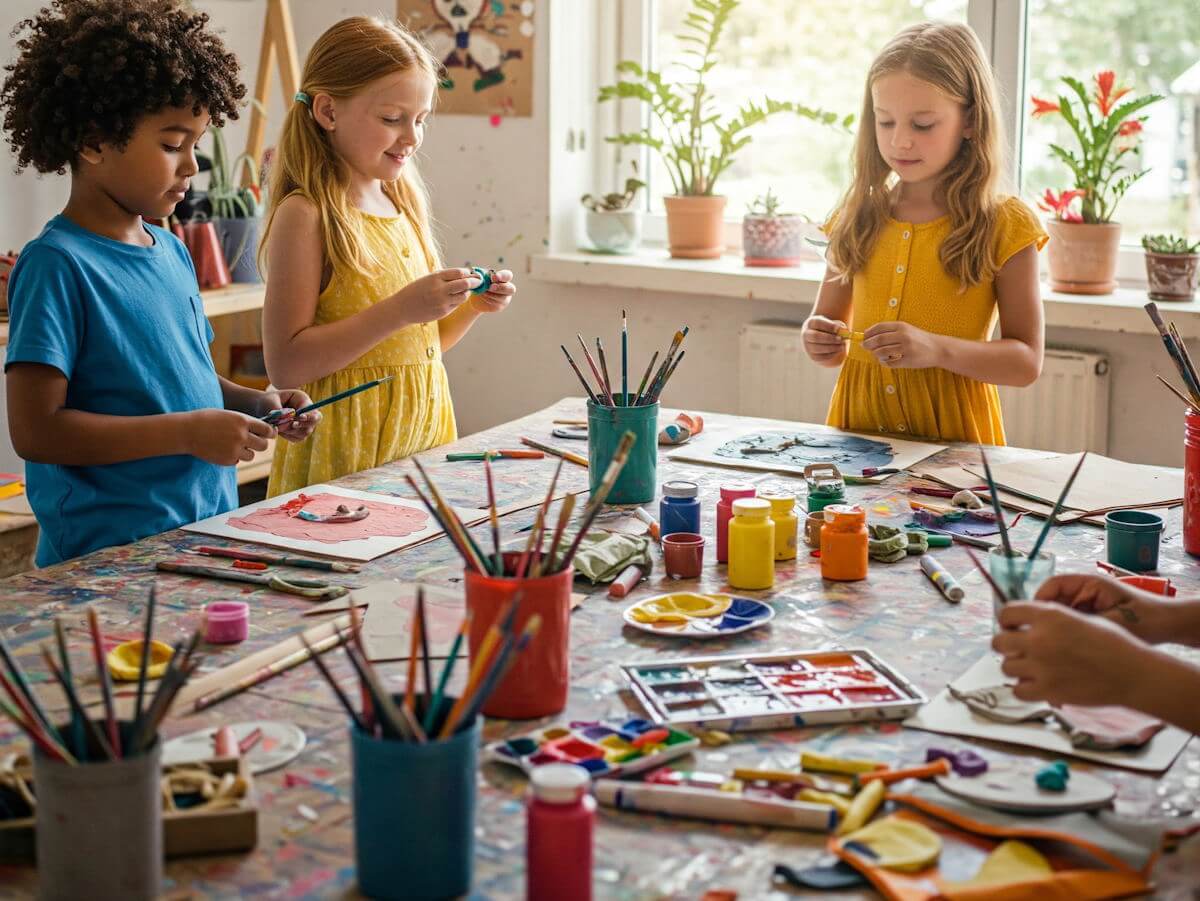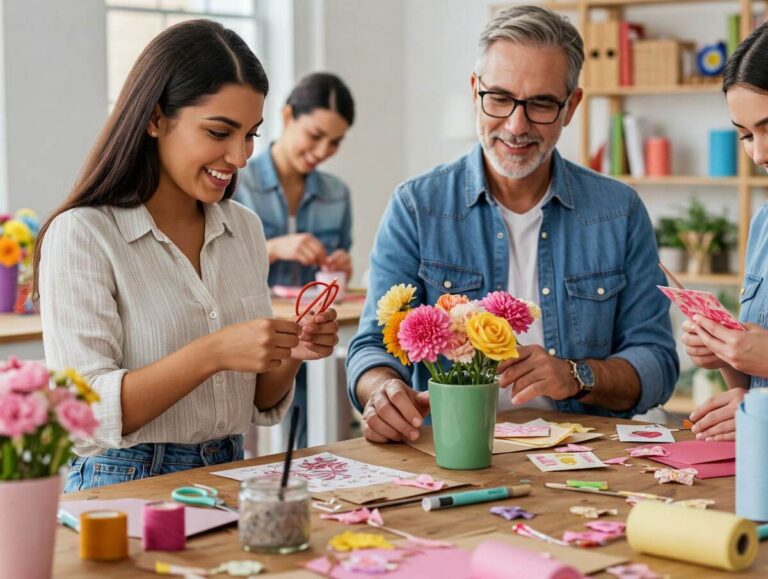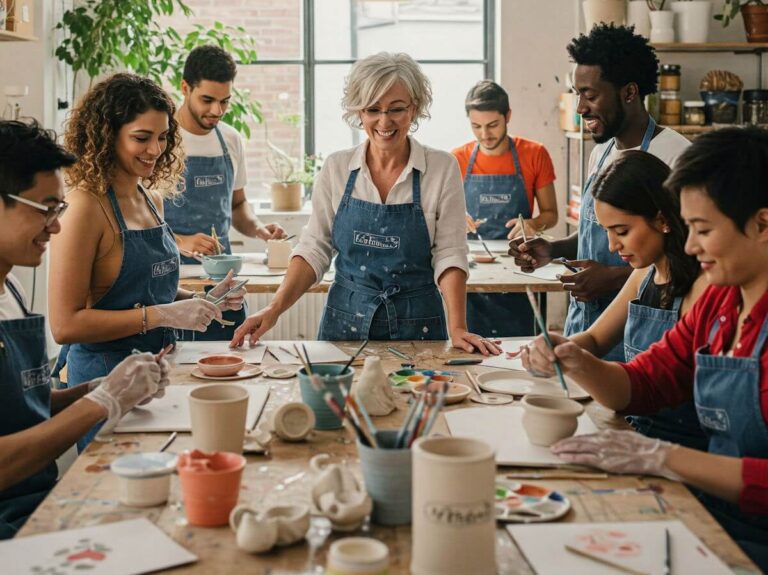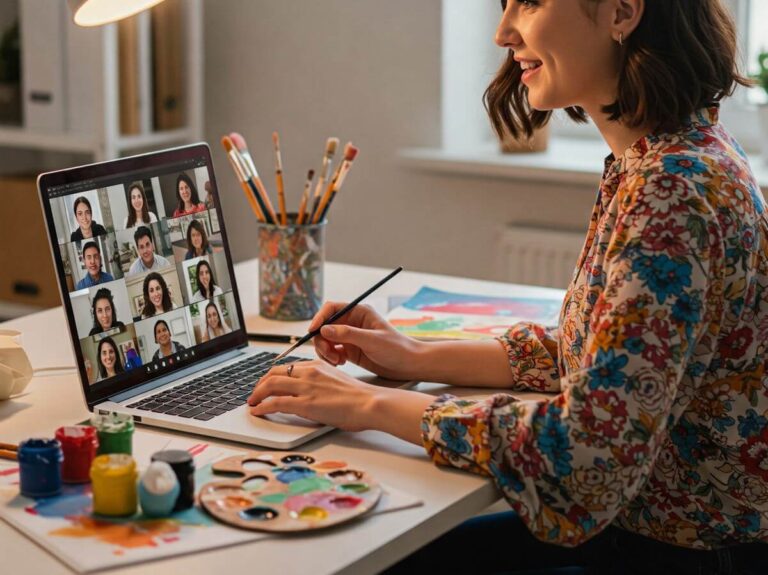Introduction to the Importance of Art for Kids
Art plays a pivotal role in the holistic development of children, serving as a foundation for many essential skills. Engaging in artistic activities not only nurtures creativity but also enhances cognitive skills, fostering critical thinking and problem-solving abilities. By exploring various forms of art, such as painting, drawing, and sculpture, kids are given the opportunity to express their thoughts and feelings in a visual format. This form of expression is crucial, as it allows them to navigate and articulate their emotions effectively.
Furthermore, participation in art activities helps boost children’s confidence. As they create, they take pride in their work, regardless of the outcome. Each stroke of the brush or pencil contributes to a sense of accomplishment, encouraging them to take risks and experiment with new ideas without the fear of judgment. This self-assuredness gained through artistic expression translates well into other areas of their lives, fostering a positive self-image and resilience.
Art also plays a vital role in the development of social skills. Collaborative art projects provide children with opportunities to work alongside their peers, teaching them the value of teamwork. As they communicate their visions and negotiate creative differences, they learn how to effectively articulate ideas and respect the opinions of others. These interactions are crucial for developing strong interpersonal skills, which are essential for building friendships and engaging in community life.
In essence, the significance of art in a child’s life cannot be overstated. It is not merely a leisure activity, but rather a comprehensive tool that promotes creativity, confidence, emotional expression, and social skills. By integrating art into the lives of young creators, we pave the way for their personal and cognitive development, nurturing well-rounded individuals capable of navigating an increasingly complex world.
Organizing a Fun Painting Workshop
Setting up a painting workshop for children is an exciting opportunity to foster creativity and self-expression. To ensure a successful event, it is essential to establish a vibrant atmosphere, which begins with selecting engaging themes. Popular themes could include nature, fantasy, or favorite storybook characters. Each theme can inspire the children’s artwork while allowing for personal interpretation, thus encouraging them to explore their artistic capabilities.
Next, gather the necessary materials. Basic supplies include canvases or sturdy paper, a variety of paint types like watercolors and acrylics, paintbrushes of differing sizes, palettes for mixing colors, and aprons or old shirts to protect their clothing. Including additional items such as sponges, stamps, and even natural materials like leaves can introduce unique painting techniques. These variations promote experimentation, allowing young creators to discover different textures and effects.
To run the workshop smoothly, follow these step-by-step instructions. Start by welcoming the children and introducing the chosen theme. Provide a brief demonstration of various painting techniques, such as blending, stippling, or using sponges to create textural effects. After the demonstration, encourage the children to select their materials and start painting. Offer assistance and feedback as needed, emphasizing that there are no wrong answers in art. If time allows, incorporate a show-and-tell session where each child can share their artwork and explain their creative process.
Creating a supportive and encouraging environment within the workshop is paramount. Children should feel free to express themselves without fear of judgment. Establishing a playful yet structured setting allows young creators to engage wholeheartedly in the artistic process, fostering a love for painting that could last a lifetime. Engaging kids in this manner can significantly enhance their artistic skills and confidence.
Crafting with Nature: Outdoor Art Experiences
Engaging children in outdoor art experiences allows them to connect with their environment while fostering creativity. Nature offers an abundance of materials that can be utilized for artistic expression. Workshops that emphasize crafting with natural elements can be both educational and enriching, providing young creators with the opportunity to explore their surroundings in a meaningful way.
One popular project involves making leaf prints. Children can collect a variety of leaves, observe their shapes and textures, and then use them to create prints on paper with non-toxic ink or paint. This activity not only promotes artistic skills but also teaches children about different plant species. Another engaging option is stone painting. Kids can gather smooth stones from their environment and use weather-resistant paints to decorate them. These painted stones can serve as unique garden decorations, enhancing local green spaces while allowing children to express their creativity.
In addition to these projects, children can create sculptures using twigs and branches. By combining natural materials with other media, such as string or glue, kids can design impressive installations that reflect their imagination. This activity encourages teamwork if done in groups and enhances problem-solving skills as they figure out how to construct their creations.
When incorporating outdoor art experiences, safety considerations are paramount. Ensure that the chosen location is free from hazardous materials, and educate children on which plants or items should not be touched. Nature walks can also accompany these activities, providing a chance for children to explore their surroundings while collecting materials. Such walks can serve as an integral part of the artistic process, teaching kids to appreciate their environment and sparking inspiration for their artwork.
Incorporating Technology: Digital Art Workshops
The integration of technology into art workshops offers a unique opportunity for young creators to explore their artistic potential. Digital art workshops can be designed to leverage tablets and child-friendly applications that empower kids to create visually stunning artworks. By engaging young artists with the latest tools, we can foster an environment where creativity thrives while providing them the skills necessary for the digital age.
To begin, selecting the appropriate devices is crucial; tablets equipped with styluses offer an intuitive way for children to replicate traditional drawing techniques. Applications such as Procreate, Tayasui Sketches, or Sketchbook are excellent resources that provide various tools for designing, illustrating, and even animating their creations. Workshops should include basic tutorials on navigating these applications, ensuring children feel comfortable as they transition from paper to screen.
Further, it’s essential to emphasize the seamless blending of traditional art skills with digital mediums. Encourage young artists to create preliminary sketches on paper before moving onto their devices. This practice not only strengthens their foundational art skills but also enhances their understanding of how techniques translate into digital formats. Incorporating hands-on activities, such as drawing or painting with traditional materials, allows children to appreciate both realms of art. This balance ensures that technology serves as a means of expansion rather than a complete replacement of traditional processes.
Additionally, fostering collaborative projects can significantly enhance children’s experiences in digital art workshops. Group activities, where children work together on a single digital canvas or engage in friendly competitions, can stimulate creativity and teamwork. Integrating digital platforms that allow for sharing and critiquing original artworks can also deepen their understanding of art as a collective endeavor.
Overall, incorporating technology into art workshops offers profound potential for engaging kids in artistic expression. By blending traditional skills with digital tools, young creators can continue their artistic journeys and prepare for a future where art and technology intersect seamlessly.
Themed Workshops to Inspire Imagination
Engaging children in art through themed workshops can significantly enhance their creativity and imagination. Various themes can be explored to help stimulate young minds, such as fantasy worlds, space exploration, and animal habitats. Each of these themes can be tailored to promote creativity through mixed media, storytelling, and collaborative projects.
For a fantasy worlds theme, children can delve into their imaginations by creating enchanted forests, magical creatures, or kingdoms filled with unique beings. Workshops can incorporate different materials such as paint, clay, and recycled items, encouraging kids to build three-dimensional models or illustrations. Storytelling can be woven into these sessions, allowing children to narrate the tales of their fantastical creations, thereby integrating both art and verbal expression into the learning experience.
When focusing on space exploration, young creators have the opportunity to learn about planets, stars, and galaxies while expressing themselves artistically. Workshops can be organized to include activities like painting their version of the solar system or constructing rockets using cardboard and colorful materials. The incorporation of science into their artistic activities aids in enhancing both their creative skills and knowledge, offering a multidimensional learning experience. Engaging in group projects, such as designing a large mural of a space scene, can further deepen the collaborative aspect of the workshop.
Exploring animal habitats presents another rich theme for young artists. Children can research different habitats, such as oceans, jungles, or deserts, and create art pieces depicting the unique flora and fauna of these environments. Activities can involve drawing, collage-making, or even crafting using natural materials. Collaborative projects can encourage teamwork while fostering a deeper connection to wildlife and environmental awareness.
When planning these themed workshops, organizers should consider the age group of participants, ensuring that the activities are age-appropriate and engaging. Providing a variety of materials and allowing children the freedom to express their interpretations of each theme can lead to an enriching and inspiring creative experience.
Art as a Learning Tool: Combining Education and Creativity
Art serves as a powerful medium for enhancing educational themes, merging creativity with essential learning. By integrating art into various subjects such as math, science, and history, educators can cultivate a deeper understanding among young learners. This interdisciplinary approach not only facilitates creativity but also reinforces cognitive development by connecting disparate concepts.
One exemplary workshop idea is to explore geometric shapes through art. In such a workshop, children can be encouraged to create their own geometric patterns using materials like colored paper, scissors, and glue. They might construct 3D models or create mosaics that incorporate shapes like triangles, squares, and circles. Through this hands-on activity, young creators gain not only an appreciation of artistic expression but also cultivate spatial awareness and problem-solving skills, fundamental components of mathematics.
Another exciting workshop can focus on the intersection of art and science. For instance, children might explore the concept of ecosystems by designing a diorama that depicts various habitats and their respective flora and fauna. This activity allows them to delve into scientific principles while simultaneously engaging their artistic abilities. They can use mixed media to represent textural elements of different environments, effectively illustrating their understanding of complex ecological relationships.
Additionally, art can serve as a medium to reinterpret historical events. A workshop that invites children to visualize a significant moment in history through painting or sculpture allows them to express their understanding in a tangible form. By researching their chosen event and then depicting it artistically, young creators can develop a deeper appreciation for their lessons, making history not just something to memorize but rather a narrative to explore and express.
Incorporating art into educational practices indeed enhances learning outcomes, proving that creativity does not exist in isolation but rather enriches various educational themes. Through art, students can foster critical thinking, collaboration, and a richer understanding of the world around them.
Fostering Collaboration: Group Art Projects
Group art projects present a unique opportunity for children to engage collaboratively while nurturing their creativity. Through teamwork, young creators learn to value diverse perspectives and develop important social skills such as communication, patience, and compromise. This collaborative environment not only enhances artistic expression but also fosters a sense of belonging and community among participants.
One engaging idea for a group art project is mural painting. Children can work together to design and paint a mural that reflects their shared interests or addresses a theme important to their community. Each child can contribute a section of the mural, allowing them to express their individual creativity while also creating a cohesive piece that symbolizes their collaborative effort. This project encourages dialogue and decision-making as children negotiate design choices and color palettes, reinforcing teamwork skills.
Another compelling option is community art installations. Children can gather materials from their surroundings—recyclables, natural elements, or donated items—to create an installation that resonates with their local community. This project teaches kids about sustainability and community engagement, all while working together towards a common goal. By creating art that honors their environment, children develop a sense of pride in their contributions, further strengthening community bonds.
Additionally, group sculptures can provide an exciting hands-on experience. Using clay, wood, or scrap materials, children can collaboratively design and construct a large sculpture. This process promotes brainstorming and collaborative problem-solving, as kids must plan their project, assign roles, and ensure that all members are actively involved. Such projects not only enhance their artistic skills but also cultivate social connections, building a supportive network among participants.
Overall, fostering collaboration through group art projects effectively promotes teamwork and community spirit while enriching the artistic journey of young creators.
Showcasing Young Artists: Organizing an Art Exhibition
Organizing an art exhibition solely focused on young creators can be a rewarding experience for both the artists and the community. The first step in planning such an event is selecting an appropriate venue. Ideal locations can range from community centers and local galleries to schools or libraries that have existing art programs. The space should be easily accessible for families and the general public, creating a welcoming environment for young artists to showcase their work.
Next, consider curating the artworks to create a cohesive and engaging presentation. This may involve setting a theme that resonates with the young creators’ experiences or interests. Furthermore, it is essential to establish clear guidelines for submissions, including size limitations, acceptable media, and framing standards. These guidelines ensure that the exhibition remains organized while allowing each child’s unique creativity to shine through.
Additionally, promoting the exhibition is crucial to attracting attendees. Utilize social media platforms, local newspapers, and community bulletin boards to spread the word. Consider also reaching out to local schools and parent-teacher organizations to encourage participation. Not only does this draw viewers, but it also reinforces the importance of supporting young talent within the community.
On the day of the event, ensure that each artist is acknowledged for their contributions. This could range from simple thank-you cards to certificates of participation, reinforcing the significance of celebrating their accomplishments. Providing young creators with a platform to display their art fosters self-esteem and nurtures their passion. An art exhibition serves as an excellent opportunity for children to express themselves, and it lays the groundwork for their future creative endeavors.
Conclusion: The Lasting Impact of Art Engagement
Engaging children in art is not merely about fostering creativity; it plays a critical role in their overall development and learning process. Throughout this discussion, we have explored various workshop ideas that not only pique children’s interest in artistic endeavors but also contribute to their emotional, social, and cognitive growth. From hands-on activities that enhance fine motor skills to collaborative projects that encourage teamwork, art engagement offers a multifaceted approach to child development.
Research has consistently demonstrated that early exposure to art can significantly influence a child’s academic performance. The skills acquired through artistic activities, such as critical thinking, problem-solving, and effective communication, are transferable to traditional learning environments. Moreover, participating in art-related projects nurtures emotional well-being, allowing children to express their thoughts and feelings in constructive ways. This process fosters self-esteem and confidence, encouraging young creators to explore their identities and beliefs.
As advocates for child development, it is essential to recognize the importance of promoting art activities in our communities. Parents, educators, and local organizations should seek to provide accessible opportunities for children to engage with various art forms. By establishing workshops, art camps, or community projects, we can create an environment that acknowledges and celebrates the creative spirit within every child. The lasting impact of these early experiences with art is profound; they resonate far beyond the immediate joy of creating. Igniting a passion for art at a young age lays a strong foundation for lifelong creativity and personal fulfillment, ultimately enriching our society as a whole.




